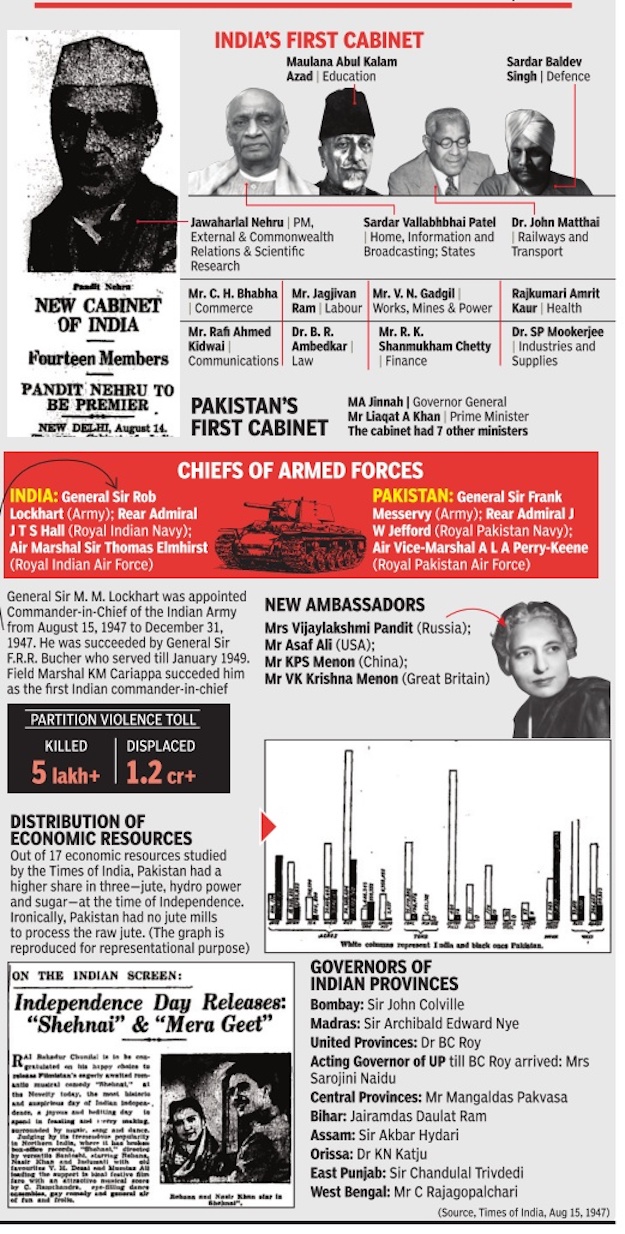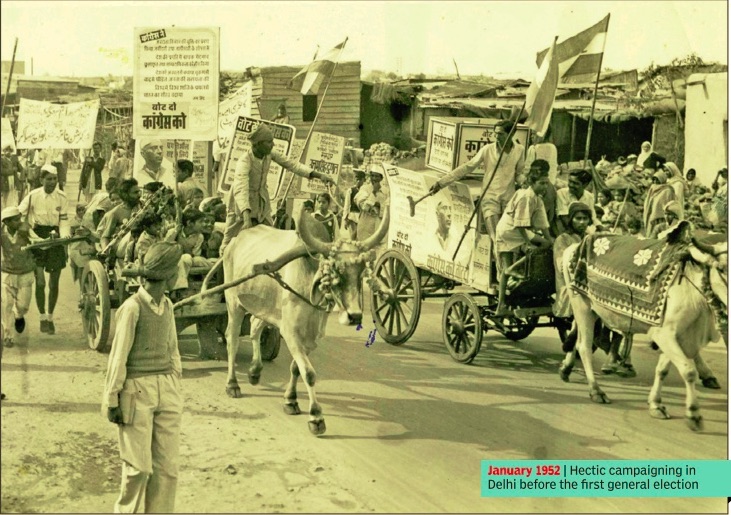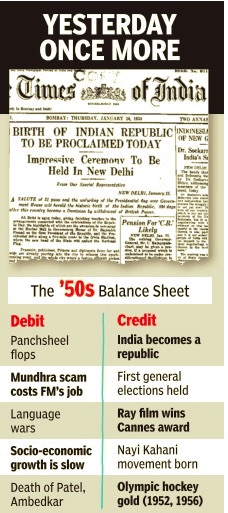India, A brief history: 1947 onwards






This is a collection of articles archived for the excellence of their content. |
Contents |
1947: Partition; the first cabinets
See graphic: State of two then newly independent nations, India and Pakistan, as on August 15, 1947

1947-67: a history of the early years
INDIA: AN UNAUTHORISED BIOGRAPHY PEOPLE, EVENTS, POLICIES, Aug 15 2017: The Times of India 1 Words to live by
Among the 20th century's stirring speeches is Nehru's `Tryst with Destiny' address to the Constituent Assembly at midnight, August 14, 1947, marking the transition to freedom. Laying out the vision for free India in 820 words, India's first PM talked of peace and service, foregrounding the themes of welfare and security in public discourse.
2 The Constitution's architect
A radical thinker rarely in agreement with Gandhians and Congress, B R Ambedkar was still appointed law minister in Nehru's first cabinet and tasked with raising a framework for modern India. He chose to underpin it with the principles of equality and justice, placing emphasis on individual rights rather than traditions, communities, and ideology. The idea of a strong Centre within a federal system of governance were also underscored through his arguments.A rare photo of Dr Ambedkar after his conversion to Buddhism
3 Bhasha battles
The language question loomed large much before states were reorganised on linguistic lines.
From the 1930s, Periyar opposed Rajaji's efforts to popularise Hindi in Tamil Nadu (Madras Presidency), and later DMK turned the stir into a movement that swept them to power.
4 India's heroes
Raj-Dilip-Dev: The troika that lorded over Bombay cinema and the nation's heart in the 1950s-60s. Dilip Kumar typified bottled, moody passion; Dev Anand was the urbane, debonair male; Raj Kapoor, the heart-of-gold, Chaplinesque hero in Nehruvian movies with songs (Awara hoon, Mera joota hai Japani) that became timeless anthems.
DID YOU KNOW?
Raj & Dilip acted together in Andaz. Dilip & Dev were lead performers in Insaniyat. Raj & Dev never shared the same screen space.
5 Song of the road
Pather Panchali, Satyajit Ray's lyrical debut feature (1955), put India on the map of world cinema and became the benchmark for every aspiring Indian auteur.
6 Road maps
India had 12 five-year plans for the economy since 1951.Although scrapped in favour of Niti Aayog's three-year action plans, the USSR-inspired plans are the reason one can drive from Kashmir to Kanyakumari without starving on the way.
7 Rise of the Reds
In 1957, the first-ever elected communist government was formed in Kerala with EMS becoming the chief minister. Invoking Article 356, PM Nehru dismissed the EMS govt in 1959, after it initiated radical land reforms and an overhaul of the education system.
8 Temples of modern India
Massive hydel projects (Bhakra Nangal, Hirakud) built in the 1950s-60s became emblems of Nehruvian development.
They set the stage for the Green Revolution but lost their sheen by the 1990s, and activists campaigned actively against them.Picture of Hirakud Dam on a Rs 100 note
9 At war
The Indian Army, its reputation burnished by WWII, was handed a morale-wrecking defeat in the Himalayas by China's PLA which came with overwhelming numbers and superior firepower.The Army's prestige was crushed, as was Nehru's spirit.
10 Peasants, workers unite
The summer of '67 uprising by peasants and tea garden workers in the picture-postcard north Bengal village of Naxalbari created the template for armed, radical Left movements that continue to thrive in swathes of India Ignored.Busts of Lenin, Stalin, Mao and Charu Mazumdar in Naxalbari
1947-64: the building of institutions
I
See graphic:Hectic campaigning in Delhi before the first general election and The 1950s Balance Sheet


A decade of nation-building under Jawaharlal Nehru provided an industrial base, a pool of scientific talent, and a legal frame for wide swathe of reforms
The first two decades after Independence belonged to Jawaharlal Nehru. He epito mised India's gigantic effort to become modern, self-re liant and remain together. There were many detractors of these efforts for they were sure that a country so divided by language and religion, racked by ancient prejudices and as poor as some of the poorest in the world, had no chance to survive.
Yet, miraculously, India survived and slowly fears of its disintegration reced slowly fears of its disintegration receded. It is not as if there were no anxious moments. Maharashtra wanted a state of its own and, before it, so did the Telu gu speaking people of the erstwhile state of Madras.The government dithered on this in the fear that this was the beginning of the dreaded Balkanisation threat that they were warned against.
However, as the States Reorganisa tion Commission finally resolved these demands it became clear that neither the newly-formed Andhra Pradesh, nor Maharashtra had any intention of separating from India. The ethos of the National Movement was stronger than what some of their leaders gave it credit for. What is more, it established the legitimacy of a state being governed in its own language -a provision that Sri Lanka, for example, failed to provide and suffered as a consequence.
What helped resolve many of these early difficulties was the fact that India had crafted a Constitution which became ef fective in 1950 and is regarded, even today , as one of the leading liberal documents of the democratic world. It established basic rights and liberties and also de-legitimised some of the ancient practices among Hindus which were unfair to women and debased many on the basis of caste.
This was a social revolution at one stroke. Doubtless, there were many leading figures who were by Nehru's side in this endeavour, Dr Ambedkar, principally , but it was Nehru's political acumen and legislative skills that eventually saw these provisions as law. He simultaneously moved against landlordism and this invited a strong backlash from entrenched quarters, but Nehru won the day .
There were other irons in the fire as well. Nehru initiated an entirely innovative economic policy that was clearly not communist or blatantly capitalist. He believed that a mixed economy was the best way for India to overcome the initial difficulties of becoming a modern industrial state.
He pushed for a strong public sector which would provide steel, energy and heavy equipment and establish the basis for sustained economic entrepreneurship in the years to come. Though the public sector is in much disrepute today, it can hardly be doubted that the infrastructural impetus that Nehru started allowed for a modern economy to develop.
All economies need knowledge, high ly skilled and technical at that, to keep them humming. There is little doubt that if India can boast of being a hub in today's information technology sector, or of producing world-class engineers and of a high-powered scientific body, it is Nehru who deserves the credit. He had the wisdom and foresight to set up the Indian Institute of Science, the IITs, the AIIMS and the IIMs, to name a few.
Alongside, in the field of culture, the Lalit Kala Akademi and Sangeet Kala Akademi and the Film and Television Institute of India were also established at his insistence. It was an all-out, four square thrust to bring India into the modern world of knowledge, sciences and the arts. Such was the vision of the man.
In foreign policy, Nehru's contribution was not nearly as singular and suf fered several setbacks, some of them during his lifetime. Both the USSR and the US were suspicious of the Non-Aligned Movement. The former thought we were being manipulated by the communists and Stalin believed that this was just a thinly disguised US plot. The India-China War of 1962 robbed all of the starch in the Non-Aligned Movement and the India-China 1952 Panchsheel Policy .
When Nehru died, he was a vastly disappointed man not just because his personal charisma had suffered a massive erosion with the 1962 China War, but also because his hopes that the public sector would man the commanding heights of the economy was not getting anywhere fast.
But, by then India was a stable, democratic republic and the fear that it would collapse was belied. Nehru showed his critics that those who ran the government were not people of straw, as often accused. Truly, this was nation building as good as one can get, for which reason that period can justifiably be called the Nehruvian years.
II
See graphic:The 1960s Balance Sheet
The building of a great edifice needs a head who enjoys intellectual, administrative and financial freedom. And he, or she, must also be young enough to have the time to succeed In social sciences, there is a rich literature on institutions, institu tional behaviour and the way insti tutions shape society, especially for relatively formal institutions like the legislature, executive and judiciary, civil society, media, business, science, technology, education and health. In debates about the legacy of British colonial rule in India, institutions figure. The pride of India's democracy isn't about elections alone, it is also about these institutions.
For the Union government, we have been told there are at least 679 autonomous bodies. These, too, belong to the category “institution“. There are others at the state level, and we mustn't forget institutions associ ated with local bodies. When we talk about “institutionbuilding“, more often than not we have in mind the Union government, less so the state and local governments.Nor do we have in mind institutions that evolve independent of govern ment, though given government's visible and invisible presence, both malign and benign, no institution in the ecosystem can afford to completely ignore government.
Ask yourself this: Why is it important for any event organised by such an institution to have government representation at inaugural or valedictory functions? Conceptually , there can be three kinds of institutions -those part of government or extended government, those ostensibly autonomous (but largely , if not entirely, funded by government), and those independent. Let's take ostensibly autonomous ones first. Even if you cannot name all 679, and this is irrespective of specific legislation under which they were set up, name a few prominent institutions, ones that, in your view, have left an imprint.
I am reasonably certain the antecedents of those prominent post-Independence institutions go back to the 1950s and 1960s, not beyond, not yet. What explains this vintage, and what has gone wrong since then? Some principles should be truisms, but aren't always appreciated. First, every individual doesn't have it in him or her to build an institution. In the narrow economics domain, there have been few like V K R V Rao.
A good academic resume doesn't necessarily make for a good institution-builder. That requires a different skill set. Second, those who select people to head institutions must possess the foresight to recognise those skill sets and recognise them sufficiently early. Back then, in that different day and age when gerontocracy and seniority didn't determine rules, peo ple were chosen as heads of institutions in their 40s, even early 40s. Notwithstanding increases in life expectancy , a person chosen as head at 58 has little time to build. Nor does that person have a stake in the future of the institution. Third, and this follows from the second, the person chosen must be given freedom, intellectual, administrative and financial, and a sufficiently long tenure.
The collapse of the third principle is almost certainly the main reason why the vintages of successful institutions are the 1950s and 1960s. Within government and extended government, the '70s was the decade when institutions, the bureaucracy and the judiciary had to be “committed“.
The steel frame rusted and the judiciary was also corroded. When there was supersession (think of the judiciary), it was based on commitment, not merit. Add to that the carrot of postretirement sinecures. For the steel frame, which is part of government, dissent has a limited role and is perforce constrained. However, for the broader ecosystem of autonomous institutions, dissent is desirable. Dissent and debate are part of democracy's discourse and require conscious nurturing for institutions to thrive and prosper. This brings me to the last principle, the lack of which, I think has been the bane.Fourth, the political leadership (there is no need to use the word government any more) has to possess confidence, an appetite for risk-taking, and have democracy in its DNA.
If you choose someone young, there is a risk you take. If you allow intellectual ferment and debate, there is a risk you take. True, the First Amendment to the Constitution curbed absolute freedom of speech and expression as early as 1951.
Nevertheless, curbing is not identical to control. Otherwise, like the Model T, there can be numerous institutions, but their colour will be identical.
1969-1975
INDIA: AN UNAUTHORISED BIOGRAPHY PEOPLE, EVENTS, POLICIES, August 15, 2017: The Times of India
12 Rajdhani on track
India's first superfast, fully air-conditioned train, Rajdhani Express, charged out of New Delhi in 1969, and musafirs developed a taste for complimentary meals. Train travel was no longer only about getting somewhere; it was also about the journey.
13 Cricket wins abroad
Two series Test wins abroad in 1971 by captain Ajit Wadekar's merry men, against the formidable Sobers-led West Indies (1-0) and the respectable Illingworth-managed England (1-0), raised the profile of cricket in India like never before.
14 Tiger, tiger burning bright
Project Tiger India's flagship conservation project began in 1973 when tigers were in decline, their number guesstimated at 1,800.
Despite setbacks that saw their number drop to 1,411 in 2006, the project has achieved a modest turnaround.
15 Military might
The only decisive war India ever fought, 1971 saw India flex both military and diplomatic muscle successfully and establish itself as a regional power. Bangladesh was born as was the icon named Indira.
16 Going nuclear
India joined the nuclear club with an underground explosion in Pokhran, Rajasthan, on May 18, 1974. Codenamed Smiling Buddha, the tests caused global consternation, but it upgraded India's status as a military power. Pokhran II happened in May 1998.
'17 Land of milk (not honey)
India's journey to become the world's leading milk producer parallels the life of Verghese Kurien, a mechanical engineer-turned-dairy-expert. He created a grid of milk cooperatives that remains the prototype for agri initiatives.
18 Green is the colour of revolution
From the 1960s, the government promoted use of high-yield seeds, chemical fertilisers and irrigation to improve foodgrain production and achieve self-sufficiency in food.
19 Darkest days of democracy
To browbeat the Opposition, Indira Gandhi declared the Emergency on June 25, 1975. Opposition leaders were jailed, civil liberties curbed, the press gagged and many forcibly sterilised in the next 21 months. In the election that followed the Congress was routed and the Janata Party swept to power.
20 Chipko movement
The act of 27 Garhwali women hugging trees to stop them from being felled in 1974 became a stencil for non-violent resistance for people's control over natural resources.
Led by Sunderlal Bahuguna, the Chipko movement inspired several environmental movements, including the Narmada anti-dam agitation.
